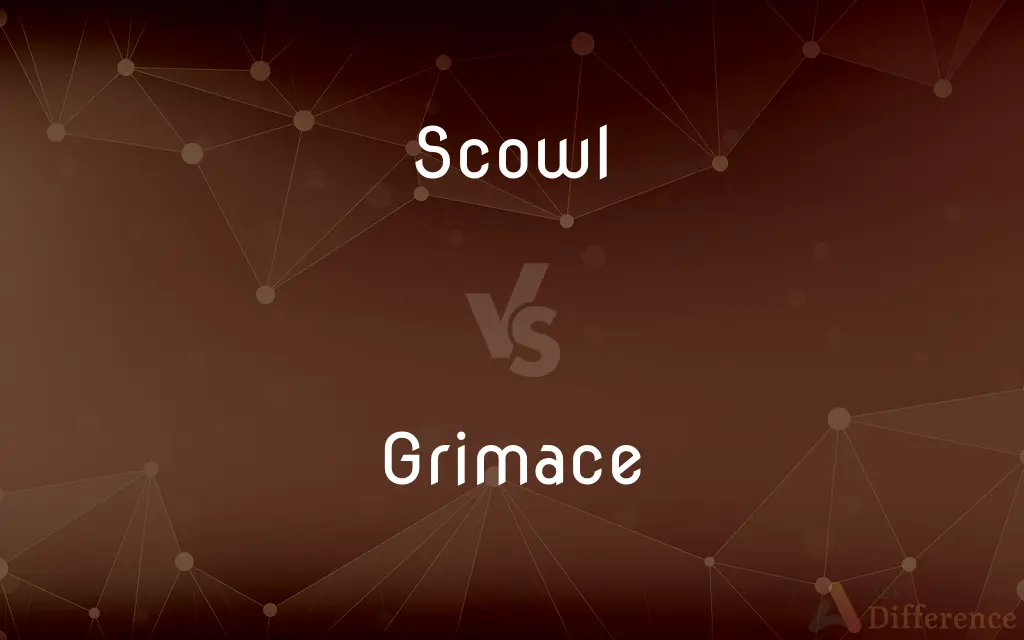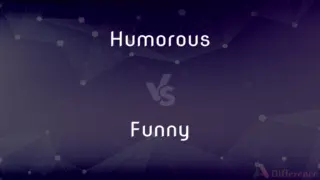Scowl vs. Grimace — What's the Difference?
By Maham Liaqat & Fiza Rafique — Updated on April 14, 2024
Scowl is a facial expression indicating displeasure or anger, characterized by furrowed brows; grimace, on the other hand, expresses pain or disgust, involving distorted facial features.

Difference Between Scowl and Grimace
Table of Contents
ADVERTISEMENT
Key Differences
Scowl primarily reflects feelings of anger or annoyance, with the eyebrows drawn together and a frown. Whereas grimace is more about showing pain, discomfort, or disgust, often with a twisted or contorted face.
A scowl is generally directed outward, signaling disapproval towards another person or situation. On the other hand, a grimace might be more self-contained, reacting to internal feelings rather than external circumstances.
When someone scowls, it's usually a response to a specific irritant or a general mood of hostility. Whereas grimacing can occur as a spontaneous reaction to sudden physical pain or a repulsive taste or smell.
Scowling can serve as a non-verbal threat or warning, indicating that the scowler is upset and possibly ready to engage in confrontation. Grimacing, however, usually does not carry an aggressive connotation; it’s more about personal reaction.
Both scowling and grimacing can be involuntary, but people might also use them deliberately to communicate their feelings without words. In the case of a scowl, the message is often one of anger, while a grimace conveys distress or aversion.
ADVERTISEMENT
Comparison Chart
Primary Expression
Anger or annoyance
Pain, discomfort, or disgust
Typical Context
Reaction to displeasure or disagreement
Reaction to physical or emotional pain
Facial Features
Furrowed brows, frowning
Twisted or contorted facial features
Communication Type
Often serves as a non-verbal threat or warning
Conveys a personal reaction, typically not aggressive
Voluntariness
Can be both involuntary or a deliberate communication
Generally involuntary, but can be used deliberately
Compare with Definitions
Scowl
To frown in an angry or bad-tempered way.
He scowled at the noisy children.
Grimace
To make a sharp contortion of the face in response to pain or disgust.
She grimaced in pain after stepping on a Lego.
Scowl
To have a gloomy or threatening look.
The sky scowled with dark, heavy clouds.
Grimace
An involuntary reaction to physical discomfort.
He grimaced when the doctor touched the bruised area.
Scowl
Expression showing disapproval or irritation.
His scowl made it clear he was not pleased with the decision.
Grimace
A facial expression usually of disgust, disapproval, or pain.
He grimaced as he swallowed the bitter medicine.
Scowl
To look at someone or something with disapproval.
She scowled at the idea of postponing the meeting.
Grimace
Distortion of the face to express an emotion.
A grimace of disgust appeared when he smelled the spoiled milk.
Scowl
An angry or bad-tempered expression
She stamped into the room with a scowl on her face
Grimace
To show disapproval or discomfort through facial expressions.
She grimaced at the suggestion of working late.
Scowl
Frown in an angry or bad-tempered way
She scowled at him defiantly
Grimace
An ugly, twisted expression on a person's face, typically expressing disgust, pain, or wry amusement
She gave a grimace of pain
Scowl
To wrinkle or contract the brow as an expression of anger or disapproval.
Grimace
Make a grimace
I sipped the coffee and grimaced
Scowl
To express (displeasure, for example) with a frowning facial expression.
Grimace
A sharp contortion of the face expressive of pain, contempt, or disgust.
Scowl
A look of anger or frowning disapproval.
Grimace
To make a sharp contortion of the face.
Scowl
The wrinkling of the brows or face in frowning; the expression of displeasure, sullenness, or discontent in the countenance; an angry frown.
She made a scowl.
Grimace
A contorted facial expression, often expressing contempt or pain.
Scowl
(by extension) Gloom; dark or threatening aspect.
Grimace
(obsolete) Affectation, pretence.
Scowl
(intransitive) To wrinkle the brows, as in frowning or displeasure; to put on a frowning look; to look sour, sullen, severe, or angry.
Grimace
(intransitive) To make grimaces; to distort one's face; to make faces.
Scowl
To look gloomy, dark, or threatening; to lower.
Grimace
A distortion of the countenance, whether habitual, from affectation, or momentary and occasional, to express some feeling, as contempt, disapprobation, complacency, etc.; a smirk; a made-up face.
Moving his face into such a hideous grimace, that every feature of it appeared under a different distortion.
Scowl
(transitive) To look at or repel with a scowl or a frown.
To scowl a rival into submission
Grimace
To make grimaces; to distort one's face; to make faces.
Scowl
(transitive) To express by a scowl.
To scowl defiance
Grimace
A contorted facial expression;
She made a grimace at the prospect
Scowl
To wrinkle the brows, as in frowning or displeasure; to put on a frowning look; to look sour, sullen, severe, or angry.
She scowled and frowned with froward countenance.
Grimace
Contort the face to indicate a certain mental or emotional state;
He grimaced when he saw the amount of homework he had to do
Scowl
Hence, to look gloomy, dark, or threatening; to lower.
Scowl
To look at or repel with a scowl or a frown.
Scowl
To express by a scowl; as, to scowl defiance.
Scowl
The wrinkling of the brows or face in frowing; the expression of displeasure, sullenness, or discontent in the countenance; an angry frown.
With solemn phiz, and critic scowl.
Scowl
Hence, gloom; dark or threatening aspect.
A ruddy storm, whose scowlMade heaven's radiant face look foul.
Scowl
A facial expression of dislike or displeasure
Scowl
Frown with displeasure
Common Curiosities
Is grimacing always a sign of negativity?
While often negative, grimacing can also occur as a humorous exaggeration of one's reaction to mildly adverse circumstances.
What does it mean to scowl at someone?
Scowling at someone is a way of showing anger or disapproval through facial expressions.
What might cause a person to grimace?
A person might grimace in response to physical pain, a distasteful flavor, or an unpleasant sight.
Can a scowl be intentional?
Yes, people often scowl intentionally to communicate their displeasure or anger.
How does a scowl differ in communication compared to verbal cues?
A scowl communicates non-verbally, often serving as a clear but silent indicator of displeasure or anger.
Is grimacing a universal expression?
Yes, grimacing is a universal expression commonly understood to indicate pain or disgust.
Can a scowl be misinterpreted?
Yes, a scowl can sometimes be misinterpreted as general hostility or unfriendliness, even if it's targeted at a specific situation.
What facial muscles are primarily used to grimace?
Grimacing mainly involves the muscles around the mouth and sometimes the eyebrows and forehead.
How do cultural differences impact the interpretation of a scowl?
In some cultures, scowling can be seen as highly disrespectful, while in others, it might be more commonly accepted.
How does facial expression of displeasure or anger show, give an example?
She wore a scowl when she saw the mess in the kitchen.
Share Your Discovery

Previous Comparison
Humorous vs. Funny
Next Comparison
Glycerin vs. GlycerolAuthor Spotlight
Written by
Maham LiaqatCo-written by
Fiza RafiqueFiza Rafique is a skilled content writer at AskDifference.com, where she meticulously refines and enhances written pieces. Drawing from her vast editorial expertise, Fiza ensures clarity, accuracy, and precision in every article. Passionate about language, she continually seeks to elevate the quality of content for readers worldwide.
















































